
Product test
The Surface clone put to the test: Dell Latitude 7200
by Martin Jud

The new Surface Studio is now available. It's certainly faster than its predecessor, and the screen is better, but it's still struggling to convince due to its outdated components.
The Surface Studio 2 is aimed at creative minds who specialise in graphic design. That's why I asked our official photographer Thomas Kunz to try this product out too. He'll give you his impressions in this article. As for me, I'll be concentrating on the performance tests and the screen.
As I said, the connectivity hasn't changed much. In addition to the aforementioned USB Type-C 3.1 port, the Studio 2 has four USB Type-A 3.0 ports, 1 Gigabyte Ethernet port, an SD card slot and a 3.5 jack. There is no Thunderbolt 3 port. Wi-Fi 802.11ac and Bluetooth 4.0 technologies enable wireless communications.
The Surface Studio 2 comes with the Surface Pen, a keyboard and a mouse. The latter is so unpleasant to use and unreliable that I recommend swapping it without delay. For the price of the Studio 2, Microsoft could have provided a mouse worthy of the name, after all, the brand makes them too. The keyboard is perfectly acceptable, but if you prefer mechanical keyboards, feel free to swap that too.
The Surface's screen is breathtaking. You can't help but marvel at this 28-inch screen in 3:2 aspect ratio. The colours and contrast are superb. The 10-point multitouch screen offers a definition of 4500 × 3000 (192 ppi).
As yet, no further information has been released. So I used our colorimeter to make a few measurements. Regarding the colour space, I obtained the following measurements:
With the brightness set to maximum, I also found a black level of 0.44 nit. This gives a contrast of 1377:1.
For performance testing, I opt for Cinebench R15, Geekbench 4 and Adobe Photoshop CC Benchmark from Puget Systems.
On all actions, Studio 2 achieves a score of 738 out of 1000. When I consider that the reference system has very recent components and those in Studio 2 are relatively old, this is a respectable result. With the workload, the fan noise is quite loud. As I'm used to gamer PCs with lots of fans, this didn't particularly bother me. But I can imagine others will be bothered by the noise.
If you'd like to see the benchmark results in detail:
The Microsoft Surface Studio 2 is out of the competition. Why? Because there is no comparable product. No AiO is as versatile as the stylus-compatible Studio 2 and the wheel called Dial. The screen is a marvel, even if it doesn't reach 100% of the Adobe RGB colour space. Creative minds will find countless opportunities to work with this tool.
Is buying the Surface Studio 2 worth it for owners of the previous one? No, the performance gain for creatives isn't significant enough to justify the 4,300-franc investment the new model represents.
The purchase of the Surface Studio 2 is worth it for owners of the previous model.
Is the Surface Studio 2 worth buying for creative people who don't already have a Surface Studio? Only if they can afford it and value design more than performance.
But then, what's the point?
But then, who should you recommend this purchase to? To those who have the budget, want to own a beautiful object and who work in design to really use the screen. Or people who only meet the first two criteria.
All others are better off buying or assembling a powerful PC. As the Studio 2 has components that are also used in notebooks, they can turn to smaller but modern processors or graphics cards. In any case, these will be more efficient thanks to the better ventilation of PCs. Add to that a screen and a graphics tablet and the bill will still be lower than for a Surface Studio 2. The whole thing will just look a little less elegant.
From big data to big brother, Cyborgs to Sci-Fi. All aspects of technology and society fascinate me.
I first experienced Surface in 2009. 2009? Didn't Microsoft wait until 2012 to launch its Surface range? you might ask. True, but before that, the Surface already existed in the form of a touch-sensitive coffee table. Surface version 1.0 was released in 2008. The second version released in 2012 was quickly renamed Pixelsense by Microsoft to avoid any confusion with the original Surface. But why am I telling you all this? Because when I was working with the Surface Studio 2, I had a bit of a feeling that I was back in 2009. The screen tilts so much that it felt like I was working on a table.
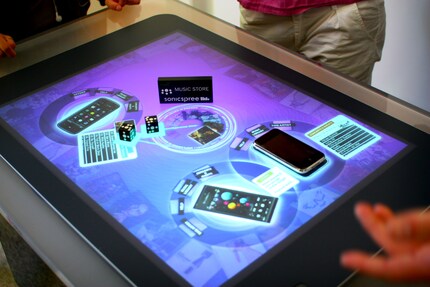
When it comes to design, Microsoft hasn't changed a thing from the previous version. Yes, you read that right: absolutely nothing has changed. Not even the dimensions. Ok, I'm exaggerating a bit. The Mini DisplayPort has been replaced by a USB Type-C 3.1 port. That's about as far as the exterior changes go, but it's not that big a deal. The previous model was a success, and its successor is just as eye-catching. Microsoft created an iconic design for the Surface Studio, why change it?
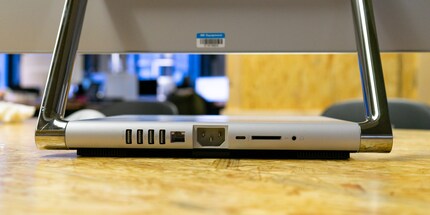
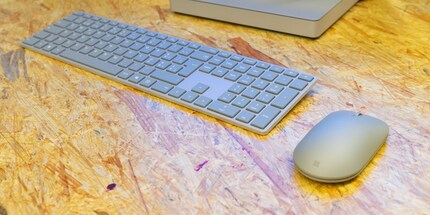
As a long-time user of Wacom graphics tablets, I love working with a stylus. I was absolutely keen to try out the Surface Studio. Here's what I said about it:
the large screen is easy to tilt. My favourite position is flat on the desk. It's comfortable. I can put my whole hand with the stylus on the screen and the surface only registers the movements of the stylus. I also like the ability to rotate and zoom with simple finger movements. The short test period didn't really allow me to fully tame the Dial. Working with it has been an experience for me. I think that the workflow can be speeded up considerably and is much more precise than with a mouse. It's a nice fast machine that's easy to use.
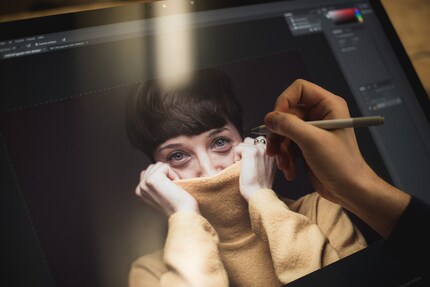
These are honourable values. It's just a shame that they're not enough to obtain around 100% of the Adobe RGB colour space. In fact, this risks disqualifying the screen for certain graphic designers who develop media intended for the final printing phase. I then measure the screen's brightness. Microsoft has improved this compared to the previous version. I obtained 519 to 606 nits with the brightness set to maximum. This means that the screen isn't quite evenly lit, but with values this high I didn't notice any difference to the naked eye. However, the measured values reveal that the brightness decreases at the bottom and the lowest value was found at the bottom left.
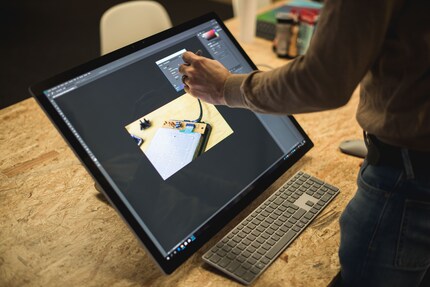
As a gamer, there's plenty to get your head around when you see the components installed on the Studio 2. The Intel Core i7-7820HQ is a seventh-generation notebook processor that's already two years old. The graphics unit is a mobile GTX 1070. At two and a half years old, it's even older than the processor. Fortunately, we're talking about the full mobile 1070 version, not the slimmed-down Max-Q design for ultra-thin notebooks. It has to be said that the Studio 2 is not designed for gamers, but for creators. That's why the system also comes with 32 GB of RAM, which demanding graphics programmes need. It has abandoned the hybrid drive of the previous model in favour of a 1 or 2 TB SSD.
I start straight away with the Photoshop test. A script makes Photoshop perform several actions. The times are recorded and compared with a benchmark system, giving a score. I run the standard test. The reference system includes the following equipment: Intel Core i9 9900K, NVIDIA GeForce RTX 2080, 64 GB RAM and a Samsung 960 Pro SSD. More information on the test can be found here.
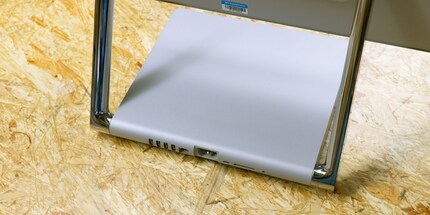
However, these good results are soon tarnished by the Cinebench R15. There, I get a CPU Score of 758 and an OpenGL Score of 105 fps. Performance-wise, the Studio 2 is on a par with the Lenovo YOGA (730-15IKB) tested last year by my colleague Martin Jud. This result is due to the same problem as on the ultrabook. The Surface Studio 2's compact construction prevents proper cooling. The components are very close together and the ventilation slot doesn't allow sufficient air circulation.
Let's move on to the Geekbench 4. This is a cross-platform performance test. It runs on Windows, macOS, Linux, Android and iOS. In version 4 of the CPU performance test, the base value of 4000 points reflects the performance of an Intel Core i7-6600U clocked at 2.60 GHz. In addition to the simulated real-world scenarios used to test CPUs (single core and multi core), Geekbench can also determine GPU performance in image processing and computer vision. You can also compare results with other systems using Geekbench-Browser. Here are the results for Surface Studio 2:
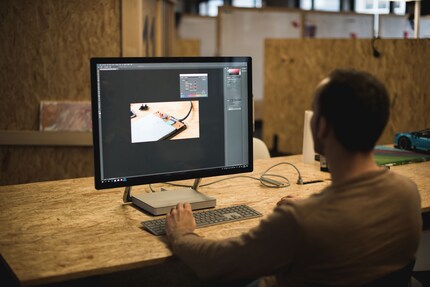
When it comes to performance, however, you can do a lot better, especially at this price. I know that the Surface Studio 2 is aimed at a specific clientele for whom the performance on offer is good enough. What I don't understand is why Microsoft is integrating outdated components. You don't need a latest-generation processor or graphics card, but please, you don't need components that are two years old or more either. If Microsoft had at least integrated a Thunderbolt 3 port, it would have been possible to connect an eGPU and, if necessary, boost the product's performance. This would have made the machine a little more durable.

Juice Technology Juice Booster 2 Swiss Traveller Set
Type 2, 22 kW, 32 A, CEE16 blue, CEE32 red, CEE16 red, Type 13